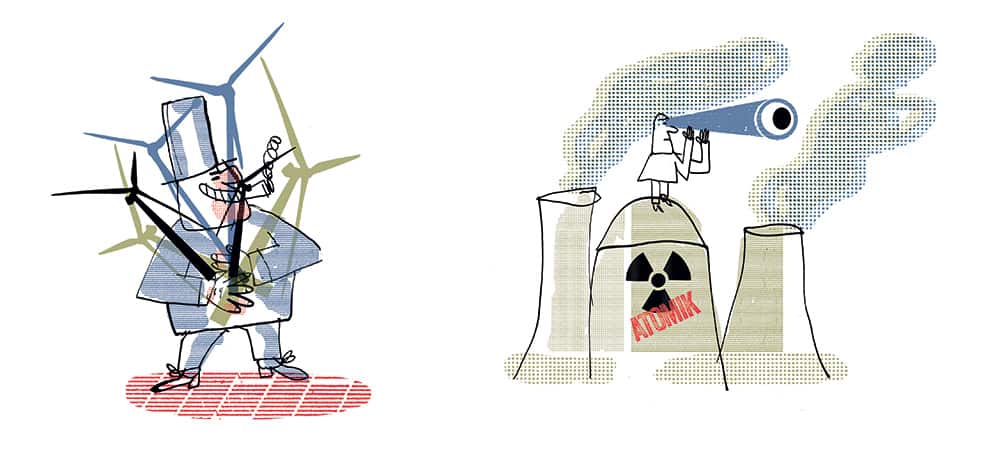10 Stereotypes about the Ecological Transition

1.It’s impossible for organic farming to feed the whole planet.
Stéphane Linou, city councilor in Castelnaudary, pioneer of the Locavore movement in France and author of the book-study “Résilience alimentaire et sécurité nationale” (“Food Resilience and National Security”).
FALSE, BUT… Regardless of the kind of agriculture we practice, it’s our consumption patterns and waste of food that are the crucial factors. We currently throw away more than 40% of our food products, and our excessive consumption of meats means we have to produce tons of grains to be used for animal feed. Two other phenomena limit the available agricultural land for food production: urban sprawl and biofuels. (Eat or drive: we’re going to have to choose!) Up to now, we have met demand through intensive agriculture, which causes greenhouse-gas emissions, pollution of our water and land, and a decline in biodiversity. Bringing our agricultural land back to life is our first task. And before we can decide whether organic agriculture can feed the world, we have to compare the harvests of organic and conventional agriculture in the context of adverse climatic conditions. We will reach a time when we will have to develop and finance a transition to organic agriculture and to change our consumption patterns. Food security is also a strategic priority, and to meet this challenge, the earthworm is definitely our best ally!
2.The electric car will save the planet.
Julien Dossier (H.95), founder of Quattrolibri, a consultancy specializing in the ecological transition, and author of “Renaissance écologique, 24 chantiers pour le monde de demain”, (“Ecological Renaissance: 24 Projects for the World of Tomorrow”), published by Actes Sud.
FALSE – An electric car doesn’t produce any CO2 when it’s driven. However, producing the electricity needed to charge it is a source of greenhouse gases. These emissions are minimal for solar and other renewable energies, moderate for nuclear energy, significant for gas, and very high for coal. In addition, manufacturing electric cars creates a lot of pollution. You have to drive an electric car around 120,000 kilometers to balance out its ecological impact. We need to make cars lighter, reduce their power, make them last longer… and increase their occupancy rate. These days, the occupancy rate is lower than it has ever been (1.2 on average!), and 50% of our trips by car are less than 5 kilometers. Carpooling and getting around on foot or by bike will be much better for the climate than transitioning to electric cars. And for longer trips, the electric car has a name: the TGV [fast train]. Let’s make our inhabited areas better by facilitating local shopping, building bike trails, privileging local train connections, and setting up carpooling and car-sharing centers. After we’ve done all that, we can turn our attention to replacing thermal-combustion engines with electric ones.
3.Renewable energies are more expensive to produce.
Benjamin Thibault (H.04), head for France of Fortum, a Finnish energy producer.
FALSE – We are still told – although less and less frequently – that renewable energies are more expensive to produce than nuclear power or fossil fuels. When we compare production costs, we have to be certain that we’re being very precise and that we’re comparing the same things. Comparisons are often biased, for example, through using years-old statistics or by looking at production costs of older plants (which have been economically amortized) instead of those of new ones. In fact, thanks to technological advances in the field, the costs of producing renewable energies have dropped significantly, to such an extent that today, new solar and wind power plants, anywhere in the world, are more competitive than any other kind of electricity production. Renewable energies are breaking records every day. France’s EDF made the winning bid to build offshore windfarms near Dunkirk for a cost of 44 euros per MWh; Akuo presented a 150 MW project for Portugal for 14.70 euros per MWh; Total and Marubeni are building an 800 MW project in Qatar for 12.30 euros per MWh… In comparison, for Hinkley Point C, the EPR [European Pressurized Reactor or Evolutionary Power Reactor] nuclear plant currently under construction in the United Kingdom, the EDF’s price was around 100 euros per MWh (92.5 GBP). For the EPR in Flamanville, the project’s initial budget of 3.5 billion euros mushroomed to 19 billion euros, and the French Court of Auditors estimates its overall cost at between 110 and 120 euros per MWh. This is almost 10 times the cost of solar or wind energy. Using renewable energies is now, without a doubt, the world’s least expensive way to produce electricity.

4.France will not be able to reach carbon neutrality by 2050 without the use of nuclear power.
Myrto Tripathi (H.03), founder and president of the association Les Voix du nucléaire (The Voices of Nuclear Power).
TRUE – According to ADEME (France’s Agency for the Ecological Transition), nuclear power emits less CO2 than any other energy source in France. Wind and solar power also produce low amounts of CO2, but their infrastructure requires a significant use of resources, more than nuclear power even when we take into account uranium extraction, plant maintenance, disposal of waste products, etc. In addition, windmills and solar facilities need backup for the days when there is insufficient wind or sunshine. Right now, when nuclear plants’ activities have been slowed down and the weather in Europe is unstable, we have had to run plants on coal! Hydropower is an attractive possibility, but it’s limited by geography. Our only low-carbon option that can satisfy the country’s energy demand is nuclear power. Reducing our energy consumption is another step we could take, but let’s be clear: France’s CO2 emissions fell by only 5% to 7% this year because of the lockdown, even though most economic activities had been stopped. It’s unrealistic to expect to cut our CO2 emissions drastically in a short period of time. In fact, the smart thing to do would be to stop focusing on electricity, whose carbon emissions have been cut by 95% and which accounts for only 25% of our total energy consumption. To reach carbon neutrality by 2050, let’s concentrate on transportation, heating, industry, agriculture; all of them are fueled mainly by pollution-causing energies. We speculate about the future and hypothetical risks posed by nuclear wastes while not paying enough attention to the real and immediate dangers of our reliance on fossil fuels (air pollution causes 67,000 deaths in France each year).
5.Digitalization fights climate change by reducing energy consumption.
Jean Carassus (H.70), professor at the École nationale des Ponts et Chaussées (École des Ponts ParisTech), author of “Le Choc, révolution industrielle, biosphère et société“ (“The Shock: The Industrial Revolution, Biosphere and Society“), published by Editions de l’Aube.
FALSE – Digitalization can indeed contribute to more efficient energy use in various sectors (construction, transportation, industry…) and can facilitate the use of renewable energies. On the other hand, this technology consumes a lot of electricity, and this electricity is usually produced by fossil fuels. Two-thirds of the electricity that powers Chinese digital giants (Alibaba, Baidu, Tencent…) comes from coal. The biggest American digital enterprises have set up their servers in Virginia (which now has one of the highest concentrations of data centers on the planet), and their main electricity supplier produces 60% of its output from coal and gas, with only one-third from nuclear power and 4% from renewables. Also in Virginia, Amazon Web Services operates with only 12% of renewable energies, while the percentages are 34% for Microsoft and 37% for Facebook. Apple data centers are the exception, since all their electricity is produced by renewable energies. Another issue, though not directly related to climate change, is that digital equipment is made from a lot of materials that are not easily recyclable, including rare metals. A smartphone contains around 60 different types of metal.
6.The ecological transition is going to eliminate millions of jobs.
Jean Carassus (H.70), professor at the École nationale des Ponts et Chaussées (École des Ponts ParisTech), author of “Le Choc, révolution industrielle, biosphère et société“ (“The Shock : The Industrial Revolution, Biosphere and Society“), published by Editions de l’Aube.
NEITHER TRUE NOR FALSE – The ecological transition is the shift from a carbon-based economy to a non-carbon-based one. In the 21st century, this transition is part of the third industrial revolution, the so-called digital revolution. According to the economist Joseph Schumpeter, capitalism is driven by innovation and operates through “creative destruction”. Every industrial revolution thus involves accelerated innovation and creative destruction, particularly of jobs. If this third industrial revolution is going to help us cut our carbon emissions, millions of jobs will be lost in the thermal-combustion-engine auto sector, aviation and fossil-fuels industries, while at the same time, millions of new jobs will be created in renewable energies, electric cars, mass transit, renovation of buildings, etc. It’s hard to say whether the final tally will be positive or negative. The main challenge is to ensure widespread and innovative professional training programs to prepare for this transition. As the Indian economist Armatya Sen points out, the most important inequalities aren’t those of income and property ownership, but rather of “capacities”, particularly the capacity to be rapidly trained to make the shift from a carbon-oriented job to a carbon-free one.
7.Carbon offsetting is useless greenwashing.
Daniel Halbheer, HEC associate professor of marketing and co-author of the study “Carbon Footprinting and Pricing Under Climate Concerns” (HEC Paris Research Paper, June 2019).
MOSTLY TRUE – Carbon offsetting involves setting a price on CO2 emissions to incite organizations to take into account their impact on climate change. By making those who produce CO2 emissions pay a “price” for them, we are trying to reduce these emissions. In practice, though, things are more complicated. Carbon offsetting allows for balancing out emissions by reducing, avoiding or storing an equivalent amount of CO2 elsewhere on the planet. Projects that lead to carbon offsetting often involve renewable energies or carbon sequestration in soil or forests. This process allows organizations to achieve a neutral net carbon footprint, even if the carbon footprint of their production activities is positive. Since these emissions are usually offset in Third World countries, their costs are too low to have much of an impact. The carbon-offsetting mechanism is, I believe, only an intermediary step. Its main positive effect is to introduce the idea that carbon emissions have costs, and this may be a wake-up call for companies and may encourage them to invest in green technologies. Penalizing companies for their carbon emissions results in a competitive advantage for activities with minimal environmental impact, independent of the marketplace. Over the longer term, we may be able to make sure economic activities are carbon-neutral by raising this price.

8.Adopting an ecological lifestyle means a return to the Middle Ages.
Julien Dossier (H.95), founder of Quattrolibri, a consultancy specializing in the ecological transition, and author of “Renaissance écologique, 24 chantiers pour le monde de demain”, (“Ecological Renaissance: 24 Projects for the World of Tomorrow”), published by Actes Sud.
FALSE – What is an ecological lifestyle? It means living without being too hot (or too cold), breathing clean air, drinking clean rather than polluted water, and eating fruits, vegetables and grains that have flavor and haven’t been filled with pesticides – or additives, sugars, salt and fats added by the food industry. It also means consuming only moderate amounts of animal-based proteins, including cheap cuts of meat, and using any leftovers to make ravioli, ground-meat dishes or meat pies. And, it means buying from local producers, and paying them well; this will result in better maintained hedgerows, smaller fields and more foliage, all of which can store carbon and support life while also making the countryside more attractive and supporting leisure activities. It means making the best use of resources and producing goods that are durable and reparable. Strengthening the agrarian economy will lead to the production of insulation and construction materials as well as the development of renewable energies (wind farms, solar farms, hydropower), fuels (biomethanization), substitutes for plastic, and active pharmacopeia ingredients. What seems simple in fact involves various kinds of expertise (biology, physics, mechanical engineering, economics, sociology), so an ecological system will create jobs. It will call on all kinds of skills and will help reduce inequality. An ecological lifestyle is founded on myriad innovations and improvements in well-being, and thus is a sign of progress and certainly not a step backwards!
9.Even if people behave more responsibly, nothing will change since pollution is caused by economic activities.
Hélène De Vestele, founder of the training collective Edeni, a start-up developed at HEC-Station F in 2018.
TRUE AND FALSE – 45%. That’s how much we can reduce our carbon footprint through strong individual commitment, in other words by changing our behavior concerning the most pollution-causing aspects of our daily lives. Going 100% vegan, for example, is the decision we can make that will have the most impact on the environment. We can also insulate our homes, favor non-polluting mobility systems…. Everything counts. 45% is not negligible. Nevertheless, 100 companies are responsible for 70% of global carbon emissions. Carbon emissions aren’t the only indicator to be considered (production of waste products, social inequalities, water pollution…), but global economic activities bear the greatest responsibility. It’s often said that demand creates supply. Marketing has shown us, however, that the opposite is in fact true. Obviously my decision not to buy anything plastic will not halt the production of plastic, but choosing a responsible lifestyle is still a necessity if we are to live according to our convictions and take control of our own consumer habits. Maybe it’s not the solution in itself, but when one person becomes more aware, that paves the way for challenging the current productivist system.
10.France is a just a drop in the bucket. China and India are the biggest producers of greenhouse gases.
Antoine Rabain (M.06), president and founder of Geckosphere (offering expertise in energy, climate and oceans), and president of the HEC Alumni Green Economy Club.
FALSE – That’s an argument that doesn’t hold up, even though France and its 67 million inhabitants account for barely 1% of global emissions of greenhouse gases. Of course we can’t directly influence China’s energy policies, which the country has the right to establish on its own, but it’s clear that we have to take responsibility for the origins of our consumer products. We also need to take into account how long greenhouse gases remain in the atmosphere. For CO2, it’s about 1,000 years. So, our climate is being disrupted today by emissions from 1980 as well as by emissions from last year! Finally, let’s compare things that are comparable. India and China are the most populated countries in the world, but the annual carbon footprint of one Indian is less than two tons, while a French person’s is around 11 tons on average. (The richest 1% of the population accounts for an average of over 56 tons per year!) Who will history show was the cause of anthropogenic climate change? They (meaning we!) must commit to achieving a post-carbon society by 2050.
Interviews by Hélène Bielak
Published by La rédaction

